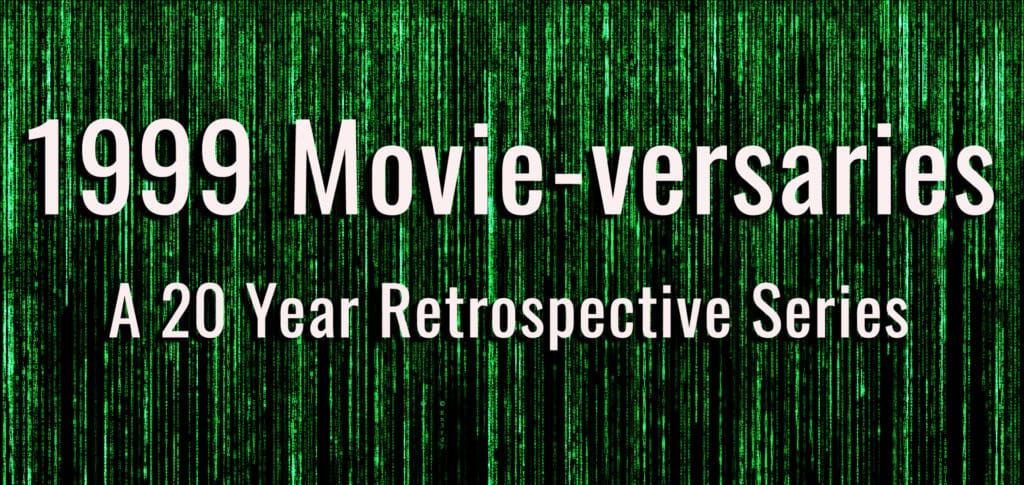1999 was a big year for movies. It was the year that The Matrix‘s slow-motion bullet influenced action movies for years to come. It was the year American Beauty won Best Picture at the Academy Awards and Oscar fans have been arguing about it ever since. It was the year Pokémon jumped from Gameboys and TV to the big screen. And worst of all, it was the year that disappointed a generation of Star Wars fans with the release of The Phantom Menace.
To celebrate that landmark year in film’s 20th Anniversary, The Pop Break continues its year-long retrospective of 1999’s most influential (at least to us) films with writer Matthew Gilbert, looking back on Pixar’s first sequel, Toy Story 2.
As the mountain of Pixar successes (The Good Dinosaur not included) continues to grow with each passing year, it can be easy to forget their third feature, Toy Story 2, which released in the fall of 1999. Since then, the studio has only gotten more ambitious in their animation and more emotionally devastating in their storytelling. But 20 years later, Toy Story 2 holds up as the high-point of the titanic series and one of the greatest sequels ever made.
Toy Story 2 was my introduction to the concept of sequels and undoubtedly the first one I greatly anticipated. Growing up, seldom did a week go by in which I did not pop our Toy Story VHS into the VCR at least twice. Like anyone my age, I was a massive fan of Woody and the gang and probably had my fair share of Buzz Lightyear (voiced by Tim Allen) toys and merchandise. But the sequel was beyond anything I even imagined. There was more toy world shenanigans and over-the-top action that I loved from the first, but there was also the genius world-building, plot twists, and heartbreak that I could not fully appreciate at the time.
Toy Story 2 begins and ends with some of Pixar’s most thrilling moments in its 25-year history. From the initial enormous title card to Buzz’s top half disintegrating, the film could not have had a more engaging welcome to Toy Story fans. The sequence even features clever homages to sci-fi classics like Star Wars and 2001: A Space Odyssey that help audiences of all ages find something to enjoy in the extended video-game level sequence. In retrospect, Pixar’s knack for this is arguably the biggest factor that has helped them find success across generations of audiences.
Meanwhile, the airport chase bears the same urgency as Toy Story‘s moving van, but it conveys even bigger stakes in a villain to defeat and a ticking clock to Andy’s return. Woody’s (Tom Hanks) final appeal to Jessie (Joan Cusack) as they jump off the ascending plane puts the perfect cap on the cowboy and cowgirl’s stories, while also providing an unbelievable action scene, both in 1999 and now.
Once the plot kicks in, it becomes clear this is both a showcase of what made Toy Story such a triumph for the studio as well as an extension of its story, world and characters. Woody and Buzz are given dual A-plots that are expertly balanced in their screen time and share of set-piece scenes and sequences. Woody’s arc dives into the sheriff’s origins as both an intellectual property and as a collectible as he grapples with the reality of his impermanence as a toy. This concept is perfectly visualized by the terrifying imagery in Woody’s nightmare near the start of the film.
The introduction of Jessie as a distillation of this theme and Stinky Pete (Kelsey Grammer) as a foil for Woody are John Lasseter and his writers’ masterstroke for the series. Pete is an evolution of the darkness which Woody overcame in the original film. His deep-seated hatred of space toys and children highlights the growth and development of Woody’s friendship with Buzz has given him. Meanwhile, Jessie’s “When She Loved Me” montage still ranks as a Top 5 Pixar tear jerking moment and provides Woody a glimpse at his future of abandonment and heartbreak if he goes back to Andy. Such developments examine the limited longevity of Toy Story as a continuing property and make the audience confront their own limited time spent with Andy’s toys.
For the first ten years, I was oblivious to all the intricacies and details that make Woody’s plot so unique. I was always more engaged with Buzz and the gang’s quest to find and rescue Woody and restore the normalcy the film so effectively establishes. Buzz’s plot has all the jokes and gags that attract kids to the series, to begin with. The traffic cone scene is still a goldmine of suspense and visual comedic brilliance, while the Al’s Toy Barn sequence probes into the film’s more explorative and adventurous side by bringing in Utility Belt Buzz and Zurg (Andrew Stanton). Mr. Potatohead’s (Don Rickles) mantra, “I’m a married spud,” was a joke it took years for me to register, but now find immensely enjoyable. Even 20 years later, both characters’ stories feel just as engaging and urgent.
Toy Story 2 for me will always be the best of the series. It is a thrilling adventure rich in character development and lovingly adorned with fun and creative moments. But it is also a more effective exploration of the growing-up ideas tackled by Toy Story 3 without relying on nostalgia and emotional manipulation—on which that film hangs all of its emotional weight. It was also the film that showed me the potential of movie sequels to develop and enrich a story world, which many sequels continue to struggle with. Though my attachment to the series has undoubtedly waned in recent years, I still find Toy Story 2 has carved out a place for itself near the top of my favorite Pixar films.


